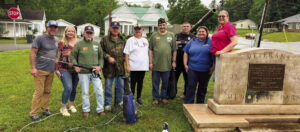Long-extinct whale unearthed at landfill
By Staff
ANCIENT BONES – James Starnes, left, and Scott Peyton clear dirt from around fossilized bones of a Basilosaurus, an extinct whale found at the Clearview Environmental Landfill southeast of Lake in Scott County. Starnes works for the state Department of Environmental Quality, while Peyton is with the state Museum of Natural Science. Photo by Keith Justice/The Newton Record
By Keith Justice / The Newton Record
Sept. 20, 2002
LAKE It looks like a cross between a snake and an alligator but it actually was much larger, meaner, deadlier and roamed the seas above the ground that now comprises much of Mississippi.
Recently, the fossilized remains of a Basilosaurus an extinct whale that flourished 40 million to 36 million years ago were found at the Clearview Environmental Landfill about six miles southeast of Lake.
At the time the creature lived, Dockery said, much of Mississippi was on the floor of a vast sea that extended north of Memphis. The Clearview landfill was likely submerged under 1,000 feet of water.
Work day begins
When Shane Weaver went to work at the Clearview Environmental Landfill on July 31, he had no idea he would make a major, historical archeological find.
Weaver operates a track hoe, a large backhoe-type machine mounted on bulldozer-like treads. He arrives at work at 6 a.m.; part of his job is to dig cover dirt for the landfill.
A landfill is laid out in areas called "cells."
Garbage is dumped into a cell; then dirt from another cell is spread over the trash. An active cell has a layer of waste, a layer of dirt, another layer of waste, and so on until the cell is full.
On that hot, July day, Weaver was digging about 8-feet deep in previously undisturbed land. He had been working for less than an hour when he hit something.
Weaver discovers fossil
At first, Weaver thought he hit a rock. But when a large, cylindrical object rolled out of the dirt, he knew it wasn't a rock.
Weaver has worked at Clearview since 1994 and had seen some fossilized remains before. In 1995, a few scattered remains of a Basilosaurus were found at Clearview.
As soon as he realized he hit the fossilized remains of a large animal, he stopped the backhoe, climbed into a nearby dump truck, and drove to the office where he reported the find to the landfill manager.
The remains of the Basilosaurus removed from the Yazoo clay of Clearview in the last several weeks represent Weaver's first fossil. Although normally the calm, quiet type, Weaver said his find has been "pretty exciting."
Creature roamed waters
Basilosaurus actually means "king lizard."
It was an aquatic predator 50-feet to 70-feet in length with jaws and teeth capable of ripping any living creature to shreds. It was the largest and most fearsome animal in the seas of the Eocene period.
Basilosaurus was misclassified as soon as it was discovered. In 1832, Judge Bry of Louisiana sent a large vertebra to the American Philosophical Society in Philadelphia, thinking he was sending a bone from a sea serpent.
Today, experts say people were wrong to classify the animal as the king of the lizards. Instead, they say, the animal is an early whale an admittedly aggressive one. Whales, and the Basilosaurus, are mammals.
Like the shark, the Basilosaurus was a large, efficient, eating machine. Fossilized remains have been found in North America, particularly in Mississippi, Alabama and Louisiana.
Workers find bones
Within days of the July 31 find at Clearview Landfill, employees from several state offices converged to salvage as much of the remains as possible.
Three weeks later, most of the animal's remains had been removed and it was identified as a Basilosaurus. Early this month, all that was left to be removed were the animal's three large vertebrae.
The remains were badly fractured, but most of the pieces were still in place. The two fractured vertebrae were encased in plaster to keep them from falling apart when lifted from their resting place.
Any fossil is "a little miracle," Dockery said, because many things can happen to the skeletal remains of an animal making it almost impossible that its bones would be preserved for millions of years.
Dockery and a crew of state employees have recovered a skull, seven cervical vertebrae, 42 of the larger vertebrae, 34 ribs and hundreds of smaller bones.










